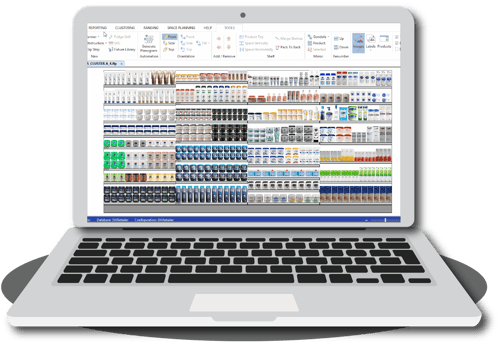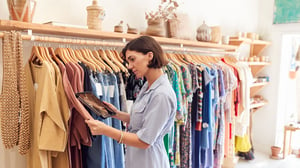
MERCHANDISING
Merchandising is any activity that contributes to the promotion and sale of products to potential customers.
In-store, merchandising refers to the display of products available in a way that motivates shoppers to make a purchase.
TABLE OF CONTENTS
WHAT IS MERCHANDISING?
Merchandising, in broad terms, is any activity that contributes to the promotion and sale of products to potential customers. In regards to in-store, merchandising refers to the display of products available in a way that motivates shoppers to make a purchase.
Another form of merchandising - visual merchandising - refers to the layout of products based on an image the retailer creates. It includes displays, decorations, and signs which complement the products available for sale.
Even though the scope of merchandising is broad, the ultimate goal of merchandising is very straightforward: to get products into the hands and baskets of your customers.
WHY IS MERCHANDISING SO IMPORTANT?

To make sales, you need to be very familiar with merchandising. Effective merchandising requires that you display products in a manner that evokes positive emotions in customers – enticing them to make a purchase.
Using best practices in merchandising, you have the opportunity to influence your customers to want to make purchases.
HOW DO RETAILERS USE MERCHANDISING?
MERCHANDISE MIX

To maximise sales and profits, retailers need to choose an efficient merchandise mix.
The merchandising mix is the width and depth of the variety of products a retailer carries for a particular category. There are various types of merchandise (products) which retailers can choose to display in-store as part of their merchandise mix.
Below are some examples:
CONVENIENCE GOODS

Convenience goods are products that customers purchase without much thought or planning. Convenience goods are staples such as milk, eggs or bread.
IMPULSE GOODS

Impulse goods are described as such because your customers decide to purchase them unexpectedly. Impulse goods rely on being displayed well at locations such as tills and check out points. Impulse goods include beverages, sweets, or complementary products.
SHOPPING PRODUCTS

Shopping products are items that customers compare based on price, quality and content before making a purchase. Examples of shopping products include high-value items such as cars, appliances and furniture.
SPECIALITY GOODS:

Speciality goods are products that customers invest considerable time into before making a purchase. Examples include products like lawn equipment, sports gear and any luxury items.
MERCHANDISING TECHNIQUES
Merchandising techniques are the methods you use to arrange and display your products in-store. They are what give form to your strategy. Depending on the objectives of each of your categories, each approach should differ by category.
Below are the four most common merchandising techniques:
VERTICAL MERCHANDISING
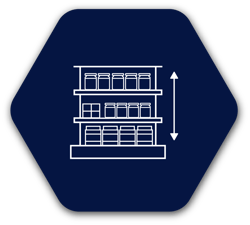
Vertical merchandising presents items in a vertical display to place products in a customer’s line of sight. The presentation allows customers to follow the products on offer with their eyes, from top to bottom, in a vertical fashion.
HORIZONTAL MERCHANDISING
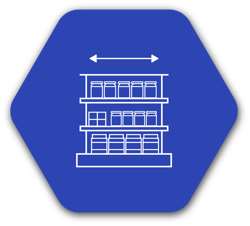
Horizontal merchandising places products in a blocked horizontal manner. It ensures that all the goods are directly in the line of sight of the customer.
It requires customers to view your products from left to right.
CROSS-MERCHANDISING
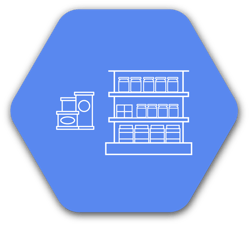
This technique, often referred to as cross-selling, entails merchandising complementary products from separate categories together to provide the shopper with solutions.
COLOUR BLOCK MERCHANDISING
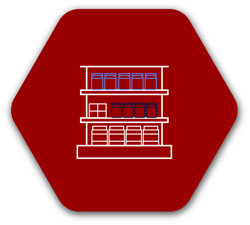
Colour blocking groups products of similar colours together on shelves. This technique is usually done vertically and is referred to as colour ribboning from time to time.
STORE INTERIORS

Have you ever visited a store that has an outdated or unappealing interior? If so, the store is probably not your favourite place to shop. The store interior is a part of merchandising because it contributes towards encouraging your shoppers to purchase products.
Interior design can determine the sales performance of a store. Store interiors contain various elements including the following:
1. FIXTURES
Store fixtures physically hold and display merchandise. They help keep products organised and in easy reach of customers. Store fixtures also create a customer-friendly display. That said, retail displays are also just as important.
2. FLOORING
Your flooring may seem of little importance, but it does make a difference. Premium carpets, for example, would suggest high quality and high priced merchandise. Other flooring examples include carpets, concrete, tiles, and wood.
3. WALLS
Wall fixtures are beneficial tools in merchandising because they efficiently use the perimeter of a store to contribute towards the sales of goods.
There are various forms of wall-mounted fixtures such as shelves, digital signs and grid wall systems.
4. FLOOR SPACE
You can use your floor space to facilitate and promote sales in a way that best serves your customers.
It is critical that you use every inch of your floor space efficiently and lay out your categories logically.
ATMOSPHERICS

In the same way that your store interior has the power to contribute (or take away from) the sale of products, atmospherics can also influence shoppers to purchase products.
Examples of atmospherics include lighting, sound, and scent.
COLOURS
A customer’s mood has a great impact on their purchasing decisions. When choosing which colour scheme to use for stores, branding and product displays should be taken into account.
Attractive colours can set the tone for a satisfying experience. Different contrasts set different moods. For example, green and blue evoke calmness and trust.
LIGHTING
Depending on the fixture, you may rely on primary lighting to provide enough light for your customers to browse products.
You can also use lighting to highlight particular displays to attract your customers to a particular product.
SOUND
Music creates a specific atmosphere that adds to the shopping experience of your customers. It connects with their emotions and moods and can influence their perception of your store’s image.
Not only does it add ambience to a store, but it also attracts specific markets and is useful for hiding disruptive and irritating noises.
SCENT
Emotions are evoked from the smell. Have you ever noticed that some stores choose to have their bakery or deli positioned close to the their entrance?
This is done to trigger positive emotions in shoppers when they enter the store.
STORE LAYOUTS
The purpose of store layouts is to maximise the efficiency and movement of shoppers through stores. Below are three different approaches to store layouts and each have their own set of advantages and disadvantages.
As a side note, there is also a fourth - the Herringbone Layout, which we discuss here.
GRID LAYOUT
Grid Layouts are store layouts in which a rectangular arrangement of counters and fixtures are placed in long rows or parallel to one another, maximising selling space throughout the store. 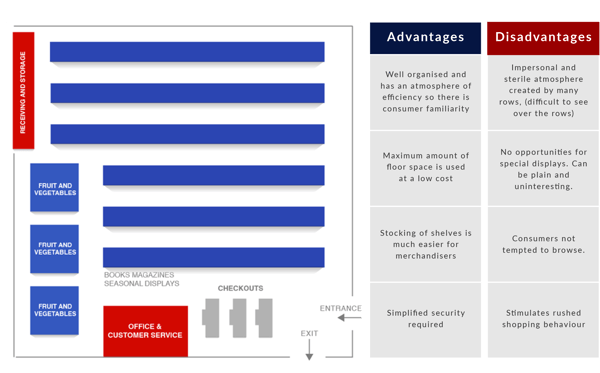
This is the most efficient use of product display and makes shopping easy for customers.
Supermarkets and drug stores are the retailers which use this layout the most.
FREE FLOW LAYOUT
In free-flow layouts, fixtures and merchandise are grouped together into free-flowing patterns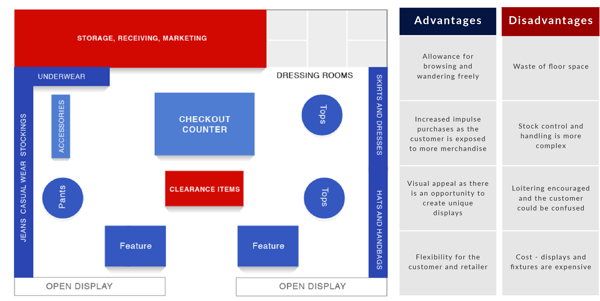
Free-flow layouts work best in stores where customers would like to take their time browsing.
Large department stores and speciality stores often implement free-flow layouts.
LOOP / BOUTIQUE / RACETRACK LAYOUT
The racetrack/boutique layout aims to expose customers to the greatest amount of merchandise possible by encouraging customers to browse through aisles and shop across various categories.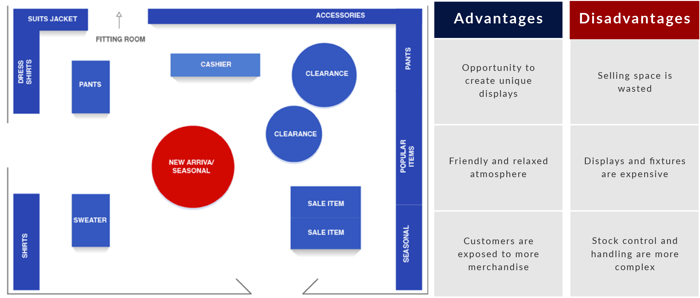
Customers are guided through specific paths in-store to browse through as many sections or departments as possible.
You can expect most departmental stores to use this layout.
WHAT ARE THE BENEFITS OF MERCHANDISING?
1. INCREASED SALES
When implemented correctly, merchandising contributes significantly to converting traffic into full baskets. Store layout and visual merchandising work together to create a memorable and consistent in-store brand experience - one in which customers can shop quickly and easily.
2. INCREASED TRAFFIC
Using merchandising helps drive visitors to your stores. Attractive exterior displays such as window displays and signage encourage customers and any passer-by to come into your store.
3. ENHANCED SPACE MANAGEMENT
Effective merchandising involves efficient floor planning – the arrangement of aisles, stack displays, gondola fixtures, shelves and the entire layout of the store.
Space management includes data-driven shelf planning and considers your financial objectives while providing your customers with shopper-friendly product layouts.
4. BRANDING
To stand out, retailers need their outlets to showcase their uniqueness and individuality consistently. One way to do this is through consistency regarding product layouts.
This creates a structured identity and brand that shoppers can recognise in several locations.
5. CUSTOMER SATISFACTION
Merchandising takes retail beyond the actual sales to delivering pleasant shopping experiences. It requires engaging with shoppers at different levels through display and promotion.
MERCHANDISING STRATEGIES

FORMULATE A MERCHANDISING STRATEGY
Merchandising strategies are the result of strategic planning based on financial objectives agreed on by executive management. It consists of various activities which vary by category depending on the objectives of the retailer.
When developing merchandising strategies, it is best practice to make it a collaborative effort between the retailer and the supplier. Suppliers are true experts in their brand categories and retailers would be amiss not to take full advantage of the supplier’s knowledge and expertise.
For every objective, there is a strategy and the most common merchandising strategies today are the following:
TRANSACTION BUILDING
Transaction Building strategies focus on increasing the size of the average category transaction, encouraging customers to purchase complementary products in addition to their original intended purchase.
This strategy also includes encouraging impulse purchases and using promotions to encourage up-trading. A good example is 3 for the price of 2.
TRAFFIC BUILDING
Traffic strategies focus on attracting your customers’ in-store and towards a category. It is a strategy most commonly used for convenience goods.
Traffic Building products are usually high loyalty items, displayed at eye level.
TURF DEFENDING
A Turf Defending strategy focuses on attracting traditional customers and is implemented to maintain and protect market share against known competitors. The strategy also focuses on keeping current customers happy and loyal.
Turf Defending strategies generally include aggressive pricing and promotion strategies to maintain existing customers.
PROFIT GENERATING
Profit Generating strategies are focused on the capacity of a category to generate profits.
An example might be grouping high-margin complementary merchandise from different categories.
EXCITEMENT CREATING
This strategy uses a sense of urgency to create excitement for products, encouraging customers to make purchases.
Excitement Generating strategies focus on impulse purchases such as offering seasonal items, latest arrivals, special items and limited editions on promotion.
IMAGE CREATING
Image Enhancing strategies communicate a particular image to customers by using quality, variety, price, service, presentation, delivery and brands available.
Be aware that these products generate word of mouth but not necessarily profit.
LET DOTACTIV HELP YOU BRING YOUR CATEGORY PLANS TO LIFE
Increase your revenue by between 5% and 30% by giving your products data-driven space allocations and applying consistent merchandising principles across your stores.
With our category management services, you’ll get quick access to the expertise, software and process required to ensure you choose ideal category roles with matching category tactics reflected in your planograms.
